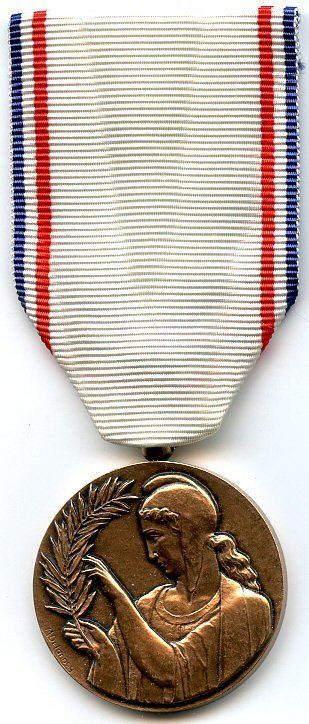Type Three grade medal Established 13 July 1917 | Status No longer awarded Distinctrecipients ~15,000 | |
 | ||
Awarded for Support to the victims of war | ||
The Medal of French Gratitude (French: "Médaille de la Reconnaissance française") was a French honour medal created on 13 July 1917 and solely awarded to civilians. The medal was created to express gratitude by the French government to all those who, without legal or military obligation, had come to the aid of the injured, disabled, refugees, or who had performed an act of exceptional dedication in the presence of the enemy during the First World War. The creation of this distinction was mainly the result of unsuccessful offensives of General Nivelle in 1917 and the serious crisis of confidence in France. The French government thus wanted to thank those who, despite the crisis, were always volunteering. It has three classes: bronze, silver, and gold. Nearly 15,000 people and communities were recipients of this award. The medal is no longer awarded, the last award was on 14 February 1959.
Contents
Award statute
The Medal of French Gratitude was awarded following World War I to the following:
Award description
The first model was a 30 mm in diameter circular bronze, silver or gilded medal depending on the level of the award, the design was by engraver Jules Desbois. The obverse bore charity personified by France supporting a wounded soldier. On the reverse at centre, the relief circular inscription "RECONNAISSANCE FRANCAISE" along the circumference with at centre and a palm leaf on the right.
The second model is a 32 mm in diameter circular bronze, silver or gilded medal depending on the level of the award, the design was by engraver Maurice Delannoy. The obverse bears a woman wearing a Phrygian cap representing France offering a palm. On the reverse, the relief inscription RECONNAISSANCE FRANCAISE around a wreath of roses surrounding an escutcheon bearing the initials "RF".
The medal hung from a 37 mm wide white silk moiré ribbon with tricolour 2 mm wide edge stripes of blue, white and red, the blue being outermost.
French citizens
Foreign nationals
Communities Decorated
The Medal of French Gratitude was awarded to six French and eight foreign cities.
